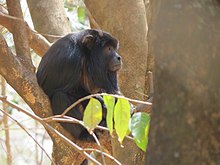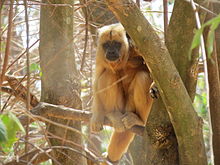Black howler
| Black howler[1] | |
|---|---|

| |
| Male in a semidecidous forest in Brazil. | |

| |
| Female in a semidecidous forest in Brazil. | |
| Scientific classification | |
| Domain: | Eukaryota |
| Kingdom: | Animalia |
| Phylum: | Chordata |
| Class: | Mammalia |
| Order: | Primates |
| Suborder: | Haplorhini |
| Infraorder: | Simiiformes |
| Family: | Atelidae |
| Genus: | Alouatta |
| Species: | A. caraya
|
| Binomial name | |
| Alouatta caraya (Humboldt, 1812)
| |

| |
| Black Howler range | |
The black howler (Alouatta caraya) (also known as black-and-gold howler[2]) is a species of howler monkey, a large New World monkey, from northeastern Argentina, eastern Bolivia, eastern and southern Brazil, and Paraguay. Together with the brown howler, it is the southernmost member of the Alouatta genus. Only the adult male is black; adult females and juveniles of both genders are overall whitish to yellowish-buff.[3] However, variations occur even among the adult males; some have patches of reddish-brown or buff fur.[3]

They live in groups of three to 19 individuals (usually seven to 9). The sex ratio is usually one to three males for every seven to nine females in a group. Mating occurs within the group.
Named for their vocalizations, they may be heard most often around sunrise. This "dawn chorus" sounds much more like roaring than howling, and it announces the howlers' position as a means to avoiding conflict with other groups. The call can be heard up to 5 km away.
These monkeys commonly sleep or rest up to 70% of the day,[2] making it one of the least active monkeys in the New World. Their habitat is forest, especially semideciduous and gallery.[2] Black howlers are folivorous, eating mostly leaves,[4] and occasionally fruit, such as figs. They generally prefer walking and climbing to running or leaping. The prehensile tail is very strong and acts as a fifth limb, allowing the monkeys greater versatility when climbing and allowing them greater safety in the occasional fall from a high branch. Because their limb structure makes terrestrial movement awkward, they spend most of their time in the trees and only come down for water during dry spells. Otherwise, the monkeys drink by wetting their hands on moist leaves, and then licking the water off their hands. Their lifespans are up to 20 years, but more commonly 15 years in the wild. In Argentina it is commonly kept as a pet due to its gentle nature.

References
- ^ Groves, C. P. (2005). Wilson, D. E.; Reeder, D. M. (eds.). Mammal Species of the World: A Taxonomic and Geographic Reference (3rd ed.). Baltimore: Johns Hopkins University Press. p. 148. ISBN 0-801-88221-4. OCLC 62265494.
- ^ a b c d Fernandez-Duque, E.; Wallace, R.B.; Rylands, A.B. (2008). "Alouatta caraya". The IUCN Red List of Threatened Species. 2008. IUCN: e.T41545A10496784. doi:10.2305/IUCN.UK.2008.RLTS.T41545A10496784.en. Retrieved 25 December 2017.
{{cite journal}}: Unknown parameter|last-author-amp=ignored (|name-list-style=suggested) (help) - ^ a b Gregorin, R. (2006). Template:Pt icon Taxonomia e variação geográfica das espécies do gênero Alouatta Lacépède (Primates, Atelidae) no Brasil. Rev. Bras. Zool. 23(1).
- ^ National Geographic
- Louise Emmons and Francois Feer. (1997). Neotropical Rainforest Mammals.

